February 15, 2011
Restoration of the Rare Mishima Baikamo Plant, Exchange with Korean NGO: Flowering Initiatives by "Groundwork Mishima"
Keywords: Newsletter
JFS Newsletter No.101 (January 2011)
"Unique NGOs in Japan" (No. 13):
http://www.gwmishima.jp/modules/information/index.php?lid=76&cid=29
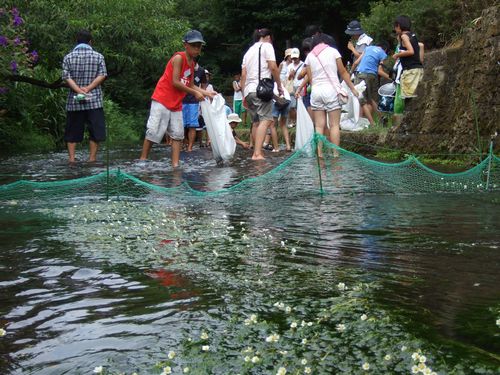
Copyright Groundwork Mishima
The city of Mishima, in Shizuoka Prefecture, is about one hour west of Tokyo by bullet train. From the platform at Mishima Station, you can see the beautiful cone-shaped Mt. Fuji covered with snow. Mishima has long been called the City of Water, because of its many waterfront areas created by the abundant spring water from Mt. Fuji.
In the 1960s, however, the supply of spring water became depleted because of excessive pumping of ground water by expanding industries, and the once-clean rivers became almost like sewage canals. Under these circumstances, citizens started taking action, saying things like, "We have to do something!" and "I want to restore the environment I enjoyed in my childhood." In 1992, eight civic groups in the city, including a spring water conservation group and a firefly conservation group, established Groundwork Mishima. Now, after years of joint efforts by many people, the waterfront environment has seen amazing improvement.
The major activities of Groundwork Mishima include the restoration of the Mishima Baikamo, a rare water plant which was first discovered there in 1930 and later disappeared from the city because of pollution. In relation to this restoration project, the group started an exchange program with the National Trust of Korea, which is also involved in the restoration of the same species of plant on Ganghwa Island in South Korea. The two organizations received the Japan-Korea International Environment Awards, sponsored by the Mainichi Daily News and Chosun Ilbo (Korea Daily News) in October 2010. The awards are designed to recognize outstanding individuals and organizations engaged in environmental conservation in East Asia. For this article, we asked Toyohiro Watanabe, Groundwork Mishima's secretary-general, about the process leading up to winning the award and about the organization's future outlook.
Mishima Baikamo -- A Barometer of Water Quality
Groundwork Mishima is the first organization in Japan to adopt the "groundwork approach," which was created in U.K. in the 1980s to improve the local environment through a partnership of citizens, non-profit organizations (NPOs), businesses, and local government. Since its founding, Groundwork Mishima has implemented more than 40 projects, including restoration of the Genbei River, conservation of historic wells and festivals for water gods, creation of habitat for fireflies, and the creation of biotopes -- a small area providing a habitat for a diversity of species -- at school sites. Many people have been involved in the activities over the years, urged on under the slogan: "With a Shovel in the Right Hand and a Can of Beer in the Left." In 1999, Groundwork Mishima became an incorporated NPO, with Minoru Oaki as director, and has now grown to a network organization consisting of 20 civic groups.
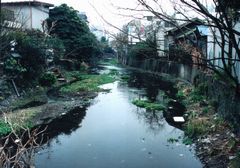
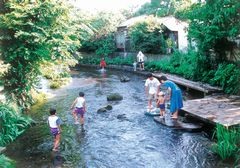
Before and after restoration of Genbei River
Copyright Groundwork Mishima
One of its main projects is the restoration of the Mishima Baikamo, a water plant belonging to the Ranunculaceae family, which produces small white flowers that look like plum blossoms. The name of the plant literally written in Japanese characters meaning "plum-blossom waterweed." This new variety was first discovered in Kohama Pond in the city's Rakujuen Park in 1930, and named Mishima Baikamo. It is a sensitive plant that only grows in clear, cold water coming from the groundwater that has filtered down through the surface layer of Mt. Fuji's volcanic soil. This makes the plant a barometer of water quality, but native-grown Mishima Baikamo in the city was lost because of a decrease in the supply of spring water.
In an effort to restore the habitat of the beloved plant with the cute flowers, an initiative was launched to create Mishima Baikamo-no Sato, a conservation area, started in 1995. To start, some Mishima Baikamo plants, which grows in the Kakita River in the neighboring town of Shimizu in Sunto District, were replanted in a spring-water pond owned by the Sano Art Museum in Mishima. Since clean water is essential to this sensitive aquatic plant, many volunteers kept up regular efforts to keep the water clean by removing sediment from the pond and doing other clean-up work. Thanks to these efforts, the number of white flowers covering the pond gradually increased. "You may ask why we devote ourselves to a plant with such small flowers," Watanabe said. "Mishima Baikamo, which grows only in clean water, is one of our local 'treasures.' It is our love for Mishima that promotes the restoration of this plant. When this beautiful bit of nature is restored, the whole city will be enriched and revitalized," he continues.

Copyright Groundwork Mishima
Baikamo Connecting Korea and Japan
One day in 2003, Groundwork Mishima received a message from the National Trust of Korea, asking to see the Mishima Baikamo. Due to the introduction of modern agriculture aiming for mass production of rice, with the help of pesticides and chemical fertilizers, Ganghwa-gun, the metropolitan city of Incheon, near Seoul, had also suffered a dramatic drop in baikamo, which used to be found in rice paddies and swamps there. The situation was almost the same as in Mishima, where the precious plants disappeared as industrial activities grew.
The National Trust of Korea has been working to preserve the 3,015-square -meters of rice paddies, named the Ganghwa Maehwamarum Habitat, since 2002. Ganghwa's mayor and landlords, as well as people from the National Trust of Korea, visited Mishima to see the restoration of the historic scenery in other paddies, wondering how Mishima was able to restore the habitat for the special plant with such small white flowers. During the site tour, the people from Ganghwa Island felt a certain empathy with the people in Mishima, who also cherish their homeland, and this started a friendship between Mishima and Ganghwa Island.
With the shared knowledge, after the people in Ganghwa Island introduced more environmentally friendly farming practices using fewer chemicals, the area of rice paddies increased rapidly from 200 to 200,000 square meters in only a few years. Finally, the baikamo came back to life and the area became home again for frogs, loaches, eels, and birds. As well, rice harvested from the paddies is marketed under the brand name "Maehwamarum Rice," which is so popular it often sells out almost immediately. Now that people in Korea are also becoming conscious about food safety, the perception that time-consuming agriculture is unprofitable has been reversed.
Also, the Ganghwa Maehwamarum Habitat became the first rice paddy to be formally registered as a Ramsar Wetland in 2008, and is known to the world as the smallest wetland registered.
To extend the network between Ganghwa Island and 23 baikamo habitats in Japan, the International Baikamo Summit was launched and has been held annually since 2007. A wide variety of people, from students to farmers, in Mishima and Ganghwa Island are visiting each other in groups, with a total of 19 visits by 320 people, including home stay programs for elementary school students, by 2010.
In recognition of their untiring efforts, Japan's Groundwork Mishima and the National Trust of Korea were selected for the 16th Japan-Korea International Environmental Award.
Now they plan to build the International Environment Education Center at Ganghwa Island as an exchange base for Japanese and Korean youth to learn to preserve baikamo. Watanabe is already thinking of the next plan, saying, "As baikamo is also found in China, Afghanistan, and Thailand, we would like to extend this baikamo exchange program throughout East Asia."
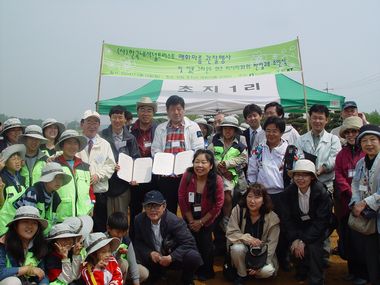
Copyright Groundwork Mishima
Passing Our Treasures on to the Next Generation through Internships
Groundwork Mishima will mark its 20th anniversary in September 2011. Fifteen years ago, it was just three buckets of Mishima Baikamo plants that were transplanted from the Kakita River to the spring-fed pond. Soon enough, the surface of the pond at Mishima Baikamo-no-Sato was fully covered with the white flowers of Mishima Baikamo. Some of them were then transplanted to the Genbei River, and now a lot of flowers can be seen thriving in the clean water. Small fish and loaches are also found there, along with flocks of birds. Besides this, as the murky river turned into a beautiful waterfront, more and more visitors have come to visit the area.
During these twenty years, Groundwork Mishima has also implemented various other projects, such as Seseragi Senior Genki Kobo (a senior's craft center), where people make woodwork items from wood harvested from the thinning of forests and bamboo from abandoned forests; an environmental community business to grow buckwheat in an abandoned field; promotion of composting toilets that utilize cedar thinning chips; revitalization of the Matsuge River on the southern edge of Mishima; and the Mishima Machinaka Cafe and Mishima Nouson Cafe, which was renovated from an old cowshed.
Furthermore, in 2010, the organization started its Groundwork Internship program to promote and develop these types of local initiatives nationwide as part of Japan's Cabinet Office's project to encourage the creation of employment in local communities. Under the program, Groundwork Mishima planned to recruit 2,400 interns nationwide for three stages from 2010 to 2011 to teach them how to revitalize the environment and run a community business, with the aim of supporting them to start non-profit organizations or local businesses in their own communities.
The first stage of the program was done from August to October 2010 with 443 interns, who reported fully enjoying the field workshops, lectures, and group work while interacting with each other. The second stage is scheduled in spring 2011 and the third in summer 2011.
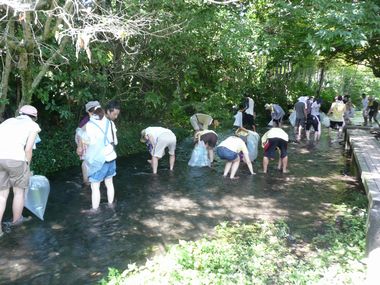
Internship in 2010
Copyright Groundwork Mishima
Mr. Watanabe says, "We hope that as many people as possible will see the results of people's efforts to revitalize nature in Mishima. During the activities in the first stage, I found that participants really cheered up when they talked with people while bathing in water from a Mt. Fuji spring. And there are many young participants, university students, in particular. We hope more and more young people will join our program to pass on this vitality to the next generation."
People's diligent efforts in Mishima have flourished, just like the flowers of the Mishima Baikamo. Now they are active in passing on their treasures to the next generation. We look forward to seeing the future development of Groundwork Mishima, with its vibrant energy and the power to send out an important message.
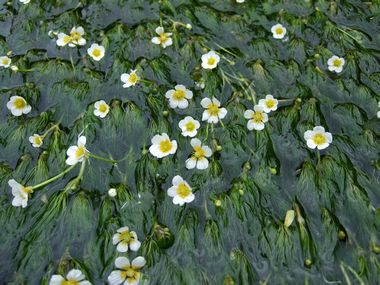
Copyright Groundwork Mishima
See also: Creating an Advanced Eco-City through Collaboration Mishima City, Shizuoka Prefecture
http://www.japanfs.org/en/mailmagazine/newsletter/pages/027943.html
Written by Taeko Ohno
Related
"JFS Newsletter"
- 'Good Companies in Japan' (Article No.4): 'Eightfold Satisfaction' Management for Everyone's Happiness
- "Nai-Mono-Wa-Nai": Ama Town's Concept of Sufficiency and Message to the World
- 'Yumekaze' Wind Turbine Project Connects Metro Consumers and Regional Producers: Seikatsu Club Consumers' Co-operative
- Shaping Japan's Energy toward 2050 Participating in the Round Table for Studying Energy Situations
- 'Good Companies in Japan' (Article No.3): Seeking Ways to Develop Societal Contribution along with Core Businesses


